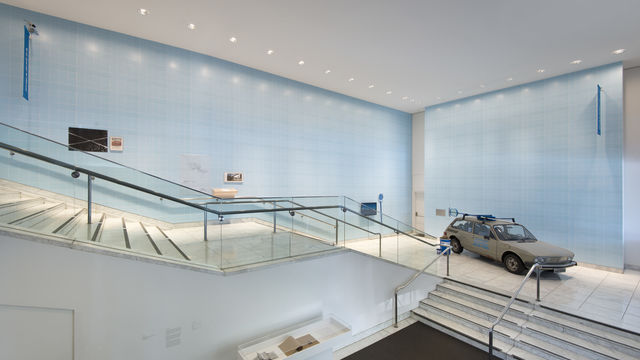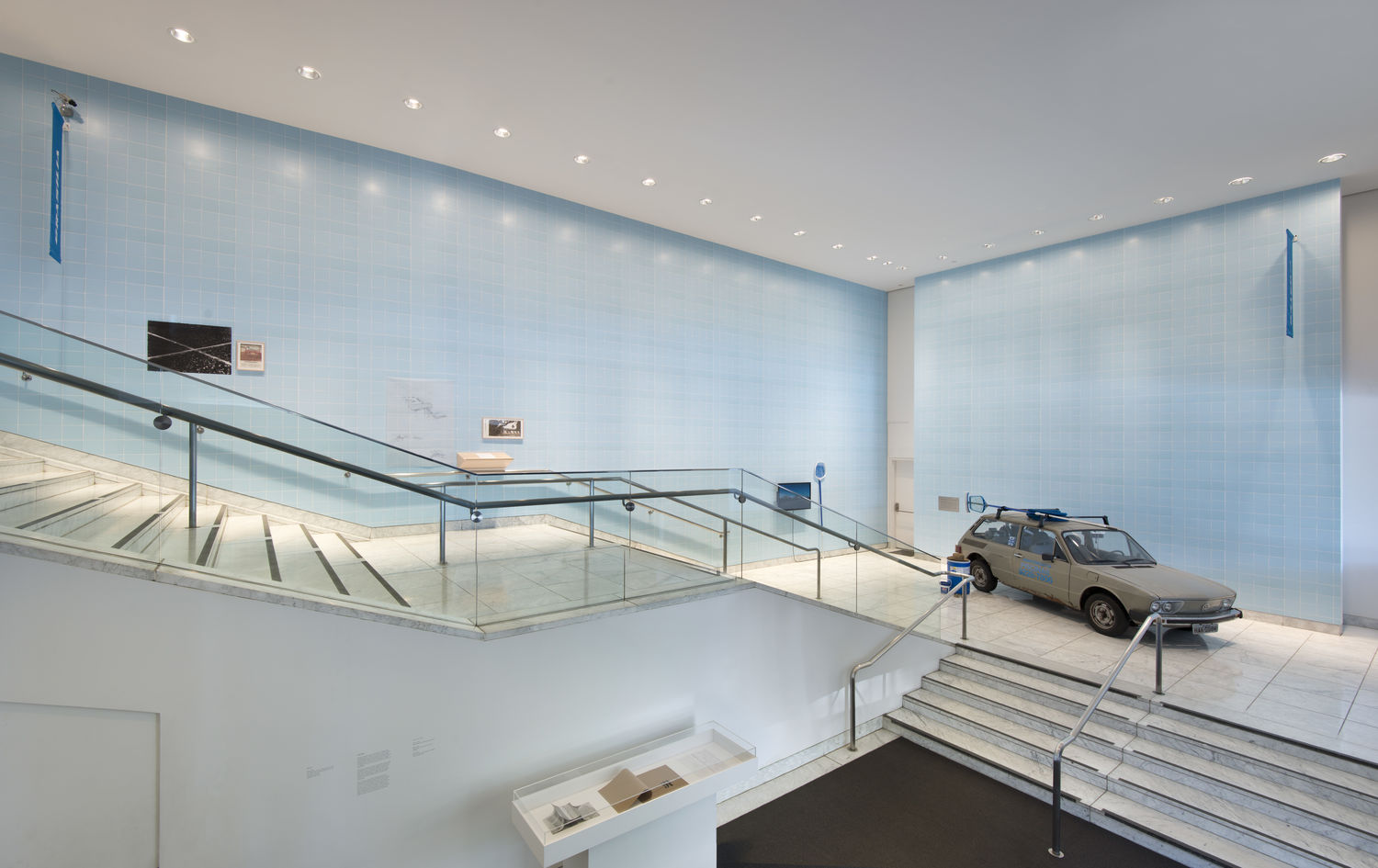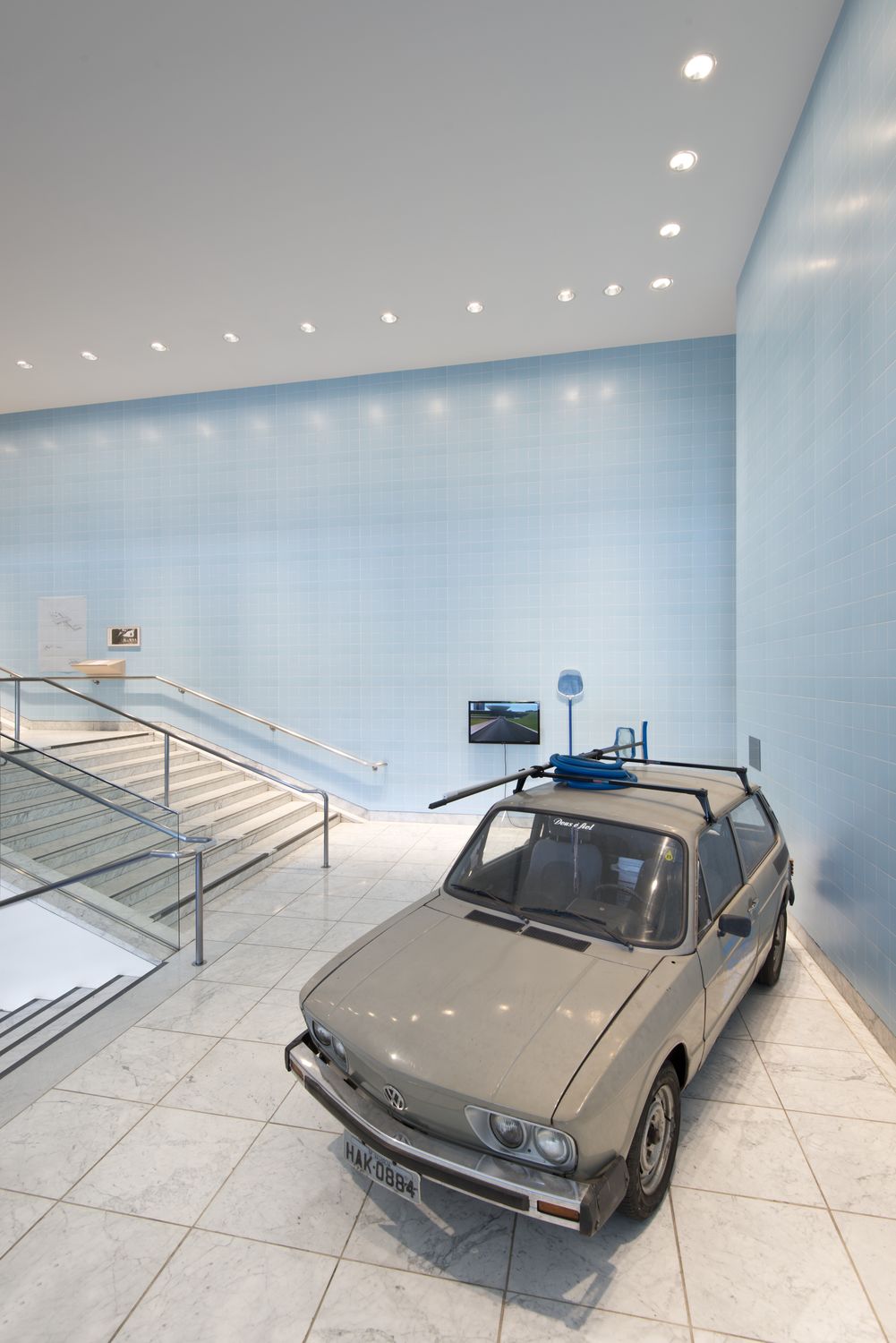
Lunchtime Art Talk Recap: Brasília at the Hammer
On Wednesday July 30, I had the pleasure of delivering a Lunchtime Art Talk to a group of Hammer Museum enthusiasts about Clarissa Tossin’s installation Brasília, Cars, Pools, and other Modernities. I met Clarissa around 2010 in Houston, Texas, when the car (the central piece of the artwork) was still in Brazil—in her parent’s garage to be more precise—and the thought of one day bringing the car to the United States was a dream wrapped in a logistical headache. Back then, Tossin was a recent CalArts MFA graduate and was beginning her tenure as a Core Fellow at the Museum of Fine Arts, Houston. After her two-year fellowship in the Core Program, she participated in San Antonio’s Artpace International-Artists-In-Residence program, which resulted in the 2013 exhibition of Brasília, Cars, Pools, and other Modernities.

Brasília
Much of Tossin’s work has to do with the utopian ideal of modernity as viewed from the perspective of class and labor in her home country, Brazil; and particularly in Brasília, the capital, where she lived for about 11 years and the city where her parents still reside. As an index of development and progress, architecture has the ability to document the identity of a place. In the case of Brasília, which one must remember didn’t become the capital of Brazil until 1960 (before that, the capital had been in Salvador and Rio de Janeiro), modernity was literally built from the ground up with most of the federal buildings designed by Brazilian architect Oscar Niemeyer (1907-2012). As art historian Mariola Álvarez has elegantly put it, Brasília is “a city that doubles as a work of art.”

Cars
The car, which is the centerpiece of the exhibition, was named after Brasília, the city. Brasilia the car, is the first Volkswagen built entirely in Brazil and primarily for the Brazilian people/consumer. Not unlike Los Angeles, it was with the car in mind that the city was planned and developed. The artist recalls how in the 1980s, the Volkswagen Brasilia seemed to stand in for a particular economic class, mostly Brasília’s working class. In this piece, Tossin evokes the pool cleaners of Brasília, who often outfitted the car in order to accommodate their pool cleaning equipment. In fact, her parent’s pool cleaner had one of these cars in light blue.
A month ago, the Hammer hosted a Flash Talk related to Tossin’s artwork that was given by Jason Torchinsky, a car journalist for the blog Jalopnik. I never thought I would be so entertained listening to someone talk for a good twenty minutes about a car but Torchinsky had my undivided attention. He drove home (pun intended!) the point that it would be more unusual to see a Brasilia driving down Wilshire Blvd. than, say, a Tesla. In his blog entry for the Hammer, Torchinsky also talked about the design of the car, which includes Volkswagen’s particular taste for placing the motor in the trunk.
Pools
As in the U.S., pools became ubiquitous in the building boom that occurred after the Second World War. Pools are also the link that connects Brasi(í)lia, the car and the city, with Los Angeles; and the video that is part of the installation elucidates this connection. In it we see Tossin disguised as a pool cleaner driving the car in Brasília and in Los Angeles and finally parking the car in front of the Strick House in Santa Monica. Now, the Strick House is the only residential building designed by Niemeyer in the US, which was mostly done over letters exchanged between the owners of the house and the Brazilian architect. Niemeyer’s affiliation with the communist party was in large part the reason why he only designed two buildings in the US: the Santa Monica house and the United Nations building in New York, which he co-designed along with Le Corbusier. Niemeyer came close to building a second home for the Tremaine family in Santa Barbara but the projected cost of the house eventually stood in the way of the house ever being built. Luckily for us, the Tremaines, who saw the true artistic value in the plans of the house, donated them to MoMA.
…and Other Modernities
As Tossin would say, in true Los Angeles fashion, the documentary veil of the video (you can see segments of it here) is a fiction created in post-production. For instance, to get the shot where she drives into the frame and the car gingerly stops in the middle of the shot was more cumbersome than the video would allow you to think. Tossin and her crew tried a couple of times but she would always stop either too far or too short of her mark. But the one time she finally landed on the right spot the carburetor exploded and that was the end of the car…but they got the shot! In post-production, she was able to clean the sound and edit the video.
There are other mementos that make up Brasília, Cars, Pools, and other Modernities. Some of the other elements you see in the installation include: an ad for a Volkswagen Brasilia from the 1970s; an archival image taken from the national archives of the main two roads in Brasília—the Monumental Axis and the Residential Axis—and printed three times, which gives the illusion of a carbon rendering; a beautiful but imaginary letter written to Niemeyer where Tossin takes him to task and asks if he ever drove the people’s car; a drawing made by her of Niemeyer’s design of the Strick House; a plaque that gives the Strick House its landmark status; pool cleaning paraphernalia; a rosary and condomblé necklaces; and several decals with messages such as ‘God is faithful,’ ‘No one holds Brazil back,’ and ‘Pool Maintenance’ along with Tossin’s old phone number in parenthesis—please don’t call, the number has been since disconnected.
But, finally, the one touch that brightens my mornings and afternoons as I enter and exit the Hammer is the wall paper mimicking pool tiles that surrounds the installation, which will remain on view in the staircase landing of the museum’s lobby until September 7. As one astute Lunchtime Art Talk participant observed, paired with the metal railing that goes up to where the car is parked, the wall paper helps immerse the viewer into the heart of Brasília.




